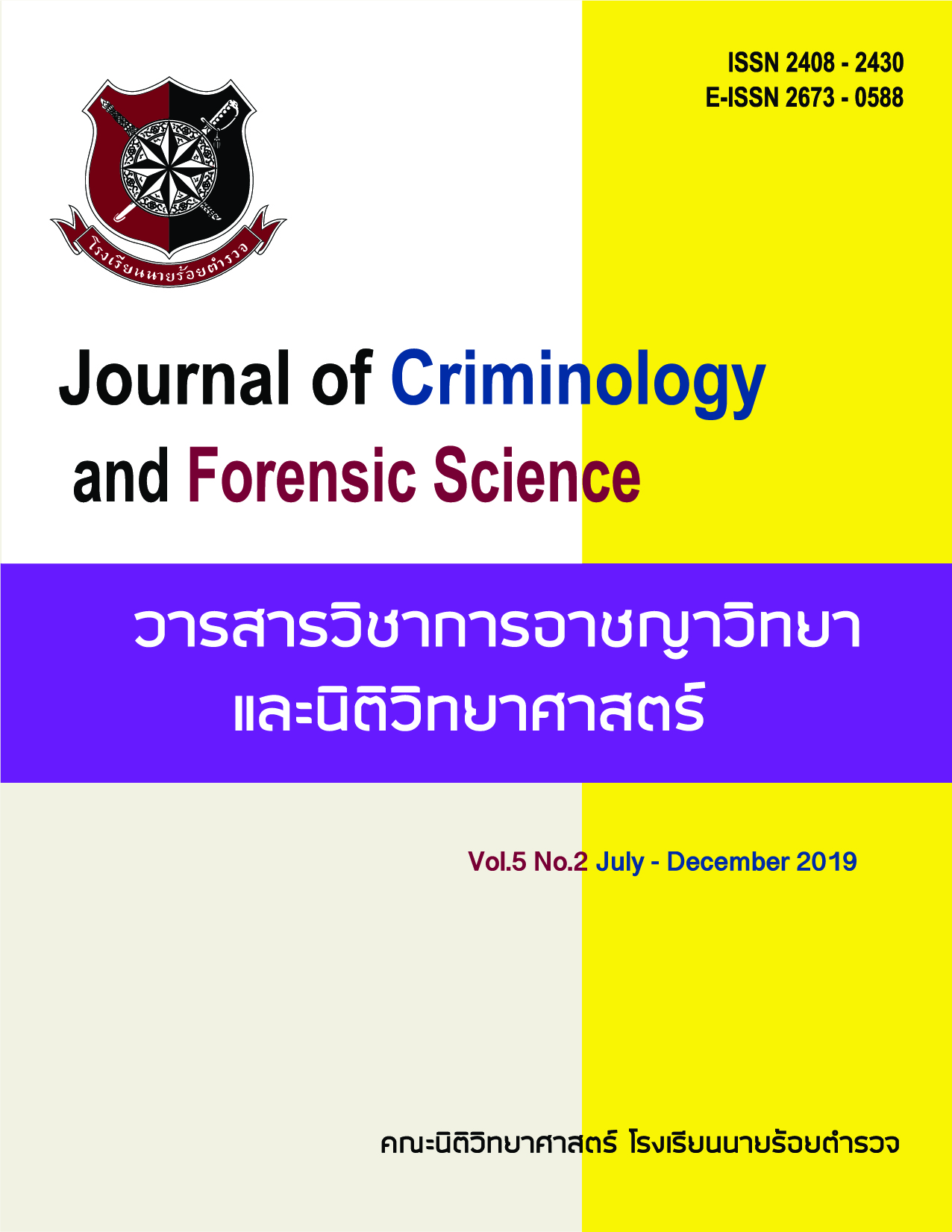การพัฒนาผงฝุ่นจากแกลบดำในการตรวจหารอยลายนิ้วมือแฝงบนพื้นผิวที่แตกต่างกัน
Main Article Content
บทคัดย่อ
การวิจัยครั้งนี้มีวัตถุประสงค์เพื่อพัฒนาผงฝุ่นจากแกลบดำซึ่งสามารถหาได้ง่ายในประเทศไทยและนำมาทำการศึกษาเปรียบเทียบการตรวจหารอยลายนิ้วมือแฝงระหว่างผงฝุ่นที่ผลิตขึ้นจากแกลบดำกับผงฝุ่นที่นำเข้าจากต่างประเทศ บนวัตถุประเภทพื้นผิวเรียบไม่มีรูพรุน ได้แก่ ประเภทกระจก ประเภทพลาสติก และประเภทโลหะ การประเมินผลการทดลองจะได้จากการนับค่าเฉลี่ยของจำนวนจุดลักษณะสำคัญพิเศษ ซึ่งผลการวิจัยพบว่า ผงฝุ่นที่ผลิตขึ้นจากแกลบดำและผงฝุ่นที่นำเข้าจากต่างประเทศ
สามารถหารอยลายนิ้วมือแฝงได้ทุกประเภทพื้นผิว ส่วนคุณภาพของรอยลายนิ้วมือแฝงพบว่า ผงฝุ่นที่นำเข้าจากต่างประเทศที่บนพื้นผิวประเภทพลาสติก ให้ผลรอยลายนิ้วมือแฝงที่ปรากฏมีความสมบูรณ์และคมชัดมากกว่าบนพื้นผิวประเภทกระจก และผงฝุ่นที่ผลิตขึ้นจากแกลบดำที่บนพื้นผิวประเภทกระจก ให้ผลรอยลายนิ้วมือแฝงที่ปรากฏมีความสมบูรณ์และคมชัดมากกว่าบนพื้นผิวประเภทพลาสติกจากผลการวิจัยครั้งนี้สรุปได้ว่า ผงฝุ่นที่ผลิตขึ้นจากแกลบดำมีคุณภาพใกล้เคียงกับผงฝุ่นที่นำเข้า
จากต่างประเทศ และยังมีราคาที่ถูกกว่า และปลอดภัยด้วยวัตถุดิบจากธรรมชาติ
Article Details
เนื้อหาและข้อมูลในบทความที่ลงตีพิมพ์ใน วารสารวิชาการอาชญาวิทยาและนิติวิทยาศาสตร์ โรงเรียนนายร้อยตำรวจ ถิอว่าเป็นข้อคิดเห็นและความรั้บผิดชอบของผู้เขียนบทความโดยตรงซึ่งกองบรรณาธิการวารสาร ไม่จำเป็นต้องเห็นด้วยหรือรับผิดชอบใดๆ
บทความ ข้อมูล เนื้อหา รูปภาพ ฯลฯ ที่ได้รับการตีพิมพ์ใน วารสารวิชาการอาชญาวิทยาและนิติวิทยาศาสตร์ ถือว่าเป็นลิขสิทธิ์ของวารสาร วารสารวิชาการอาชญาวิทยาและนิติวิทยาศาสตร์ หากบุคคลหรือหน่วยงานใดต้องการนำทั้งหมดหรือส่วนหนึ่งส่วนใดไปเผยแพร่ต่อหรือเพื่อกระทำการใดๆ จะต้องได้รับอนุญาตเป็นลายลักษณ์อักษรจาก วารสารวิชาการอาชญาวิทยาและนิติวิทยาศาสตร์ ก่อนเท่านั้น
เอกสารอ้างอิง
2.Amornmongkol, P. (2009). The development of fingerprint powder for forensic use.
Master of science program in forensic science Silapakorn University, Nakhon Pathom. (In Thai).
3. Garg, R. K., Kumari, H., & Kaur, R. (2011). A new technique for visualization of latent fingerprints
on various surfaces using powder from turmeric: A rhizomatousvherbaceous plant (Curcuma longa). Egyptian Journal of Forensic Science, 1, 53-57.
4. Kumari, H. R., Kaur, R., & Garg, R. K. (2011). New visualizing agent for latent fingerprints:
Synthetic food and festival colors. Egyptian Journal of Forensic Science, 1, 133-139.
5. Mophwng, S. (2009). Production of latent fingerprint powder from banana peeling
activated carbon. Master of science program in Naresuan University. (In Thai).
6. Nualkul, M. & Eksinitkun., G. (2017). Latent fingerprints development on non-porous wet surfaces using small particle reagent based on nano-znO. Master of science program in forensic science Silapakorn University, Nakhon Pathom. (In Thai).
7. Royal Thai Police. Police Forensic Science Division. (1995). Detection of fingerprints at
the scene of the incident. Training papers detection of fingerprints at the scene of the incident.
8. Sangkaew, S. (2012). Production and evaluation of fingerprint powder made from coal. Master of science program in forensic science Silapakorn University, Nakhon Pathom. (In Thai).
9. Seangsawang, N. (2010). The study in characteristics of magnetic fingerprint powder.
Master of science program in forensic science Silapakorn University, Nakhon Pathom. (In Thai).
10. Sonkunthod, C. (2007). Applying Computer Program for Fingerprint Identification.
Master of engineering program in industrial production technology Kasetsart University, Bangkok. (In Thai).
11.Sodhi, G. S. & Kaur., J. (2001). Powder method for detecting latent fingerprints: A review.
Forensic Science International. 120 (September), 172-176.
12. Songnonlek, N. (2012). Development of latent fingerprint on non-porous surface by
using turmeric powder. Master of science program in forensic science Silapakorn
University, Nakhon Pathom. (In Thai).
13. Tiprong, H. (2015). Development of black powder from wood charcoals for the detection of latent fingerprints on ceramic, plastic and paper cups. Master of science program in forensic science Silapakorn University, Nakhon Pathom. (In Thai).
14. Theangtheantham, S. (2013). Development of latent fingerprints on objects submerged in natural water by using small particle reagent and black powder. Master of science program in forensic science Silapakorn University, Nakhon Pathom. (In Thai).


